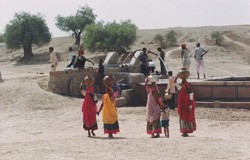
Challenge
For villagers in the arid Marwar region of Rajasthan, India, decreasing groundwater levels and repeated droughts have destroyed traditional livelihoods. During the long dry season, farmers and herders get most of their water from wells. In recent years, some groundwater levels have dropped as much as 400 feet. One of the world's most densely populated arid regions, Marwar's droughts starve cattle and cause mass migration of people and their livestock. Farmers are forced to pay a high price for drinking water transported great distances by tankers, and many fall into debt taking out loans from local moneylenders.
Initiative
With support from USAID, India's Jal Bhagirathi Foundation helps communities design, build and manage systems that harvest rainwater. Since abundant rain falls during the summer monsoon season, communities are shown how to preserve some of the rainwater for use in the dry season — which also helps raise the groundwater level. Jal Bhagirathi has also helped village communities better manage water resources by rehabilitating traditional water harvesting structures, constructing new ones and developing sanitation facilities for schools. In Jodhour and six other districts, jal sabhas (water groups) have been formed to raise awareness of water management techniques that improve conservation, eliminate erosion and increase vegetation.
Results
Since the program began, 82 water harvesting structures have been built, providing ample sources of water to the 17,000 residents of more than 200 villages. The rainwater collected in newly built johads (small earthen check-dams) has helped recharge wells, increase vegetation and food production, and, in many areas, brought displaced people back to their homes. In Alwar district, investment in johads has resulted in a 300 percent increase in economic production. Through local and effective management of this precious resource, communities have become, once again, self-reliant, actively participating in the long-term management of their natural resources.







Comment
Make a general inquiry or suggest an improvement.